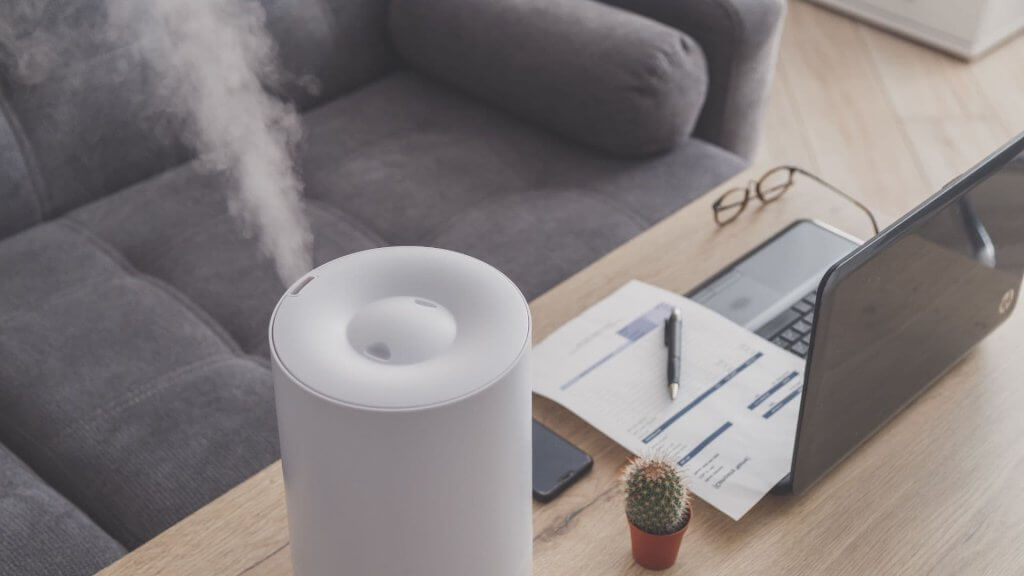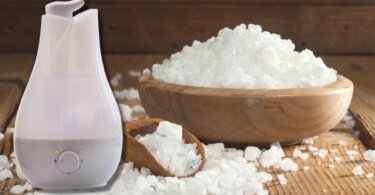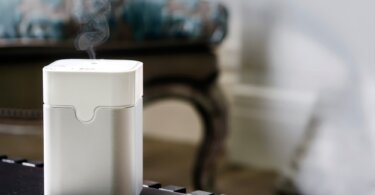If you’re like me, you probably enjoy the added benefit of a humidifier during the dry winter months. When it makes the indoor air more comfortable, you can sleep and work more peacefully.
However, if you haven’t cleaned your humidifier in a while, you might wonder what that brown stuff is accumulating in its tank. Here’s what it is:
That brown stuff in your humidifier is most likely sediment from the water that’s being used. Over time, this mineral content can build up and cause problems with your humidifier’s performance. If you notice that the brown stuff is starting to accumulate, it’s best to clean out your humidifier right away.
To make sure that your humidifier’s water tank is always clean and doesn’t become a ground for mold, we’ll look at what that brown stuff is and how to clean your humidifier to prevent it from forming. If you want to keep mineral deposits and mold particles out of your breathing air, read on!

What Is That Brown Stuff In Your Humidifier, And How Does It Form Over Time?
The brown stuff in your humidifier is caused by minerals like calcium and magnesium buildup. These minerals can be found in tap water from both public water systems and private well systems.
In the case of hot water, the minerals are released into the air and cause the brown gunk to form. Therefore, it’s better to use distilled water in the humidifier’s water reservoir to keep these deposits at bay.
Other than common minerals, different types of spores can also accumulate in the humidifier, leading to the harmful formation of buildup material.
While this brown buildup is unsightly and can sometimes smell bad, it’s not always harmful to breathe in. However, it is best to clean your humidifier regularly to prevent any buildup from occurring.
You can use vinegar or bleach to clean your humidifier or buy a commercial cleaner specifically designed for humidifiers.
Moreover, regularly changing the humidifier water and cleaning leftover water droplets around the humidifier can also reduce the amounts of minerals you see around it.
How to Prevent Mineral Buildup in Your Humidifier?
If you suffer from breathing conditions and allergies, you know how important it is to have a humidifier in your home.
But did you know that if you don’t remove that brown substance in water, your humidifier can do more harm than good?
Mineral and mold buildup are common problems with humidifiers, but there are ways to prevent them. Here are a few tips:
1. Change The Water Daily
This may seem like a no-brainer, but it’s important to change the dirty water in your humidifier every day. Otherwise, the growth of bacteria and other microbes will foster, leading to mineral buildup and mold particles.
2. Clean The Humidifier Filters On Time
In addition to using clean water, you should also clean your humidifier regularly. This will help prevent mineral and mold buildup, as well as keep your humidifier working properly.
If your humidifier’s filter basket is loaded with mold and minerals, it’ll quickly lead to respiratory conditions and airborne bacteria in your home.
3. Use Distilled Water
If you’re using tap water in your humidifier, it’s more likely that mineral and mold buildup will occur. Distilled water is a better option, as it doesn’t contain the same impurities that can cause buildup.
By following these tips, you can prevent mold and calcium buildup in your humidifier. If you do notice any buildup, be sure to clean it immediately to avoid any health problems.
Related article: can you use a humidifier without a filter?
Can Mineral Deposits In the Humidifier Make You Sick?
Mineral deposits and leftover water in a humidifier can make you sick. Over the period of time, these mineral deposits and black water will build up and create a breeding ground for bacteria and the growth of mold. This can lead to respiratory problems like asthma and other respiratory infections.
To prevent this from happening, it’s important to clean your humidifier on a regular basis. You should also use distilled water in your humidifier, as this will reduce the number of minerals accumulated in its tank.
Wrap Up
Mold and mineral buildup in your humidifier can reduce its efficiency and pose health risks to you and your family. Regular cleaning and maintenance of your humidifier will prevent the growth of mold and deposits of minerals. Be sure to follow the manufacturer’s instructions for how often to clean your humidifier.
In addition, empty and refill the water tank daily and use only distilled or demineralized water. Taking these simple steps will help you enjoy the benefits of your humidifier while keeping your family safe from harmful contaminants.
FAQs
What is Brown Stuff in a Humidifier Tank?
The brown dust in a humidifier tank is most likely sediment from the water. This can gather over time as the water evaporates and leaves behind minerals and other impurities.
What Is The Health Risk of a Dirty Humidifier?
Other than common minerals, different types of spores can accumulate in the humidifier, leading to the harmful formation of buildup material.
When these spores become airborne, it’s possible to breathe them in. This may cause sore throat, respiratory issues, and trigger allergies.
Why Is a Humidifier a Good Idea?
First, if the humidity level in your home gets too high, it can create an ideal environment for mold and mildew to grow.
In addition, humidifiers can increase your risk of developing respiratory problems such as pneumonia or bronchitis because of mold spores.
Finally, too much humidity can trigger an attack if you have asthma or allergies. That said, if used properly, humidifiers can provide great health benefits such as relieving congestion and sinus problems, moisturizing your skin, and helping you sleep better.
What Are The Best Ways To Get Rid of Calcium Deposits in Your Humidifier?
Here are some quick tips to reduce calcium deposits in your humidifier:
- Clean your humidifier according to the manufacturer’s instructions. This will help remove any buildup of minerals that could cause problems.
- Use distilled water instead of tap water in your humidifier. Distilled water contains fewer minerals than tap water and is, therefore, less likely to leave deposits behind.
- Use a good-quality humidifier filter. These air filters trap minerals and other contaminants, preventing them from entering your breathing system. This ensures the water residue in your humidifier doesn’t make you sick.
Related article: purified water vs distilled water for humidifier
What Are The Dangers of Pink Mold?
Pink mold is a type of fungus that can cause several health problems. It can cause respiratory problems, skin irritation, and even organ failure.
It’s important to avoid exposure to pink mold spores whenever possible and to seek medical attention if you think you may have been exposed to them.
Symptoms of pink mold exposure can vary depending on the person, but they often include coughing, sneezing, watery eyes, and skin irritation.
Related articles:
How to Prevent Mold in a Humidifier
Can a Humidifier Cause Mold on Walls?
My Humidifier Gets Everything Wet on the Floor





Leave a Comment